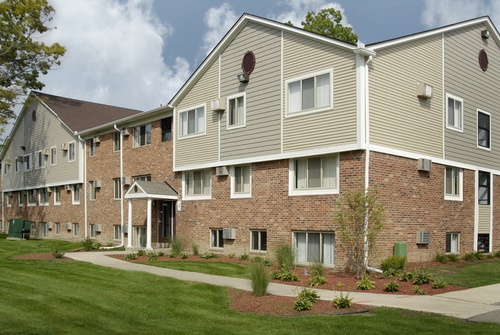About Mid-America Apartment Communities
Ladies and gentlemen, boys and girls, it is REIT time.
For all those that are not as cool as me out there and don’t know what a REIT is, it is an acronym (duh) that stands for “real estate investment trust,” and it is the designated title of a company that typically generates the bulk of its revenues through leasing out hard real estate, usually generating income in the form of rent from its tenants. Interestingly enough, REITs in the United States are legally subjected to distributing 90% of their taxable income to its shareholders, acting as a sort of form of mandatory cash flow for investors or holders of the REIT’s publicly traded stock.
The REIT investor is basically reaping the benefit of owning a piece of the company in the form of stock and for owning stock, receives a portion of the cash flows that the company generates through its real estate operations, or the rent it receives from tenants.
It is investing in real estate in a smaller and unarguably more liquid and secure fashion for the everyday investor such as you and me, hence the mass appeal and rapid rise in popularity in recent years.
Sure, REITs are interesting investment vehicles in their own rights, but I would be selling you short if I didn’t mention that the main reason I wanted to research and write about this company and its stock (NYSE: MAA) was because hedge funds updated their 13F filings (that is, an SEC filing that contains the holdings in their recently updated respective portfolios) rather recently and one of my favorite hedge fund managers to monitor, Stan Druckenmiller of the Duquesne Family Office, reported a brand spankin’ new position in Mid-America Apartment Communities in his most recent filing, and suffice it to say, my nerdy interests have been piqued.
Headquartered in Memphis, Tennessee, Mid-America Apartment Communities, if you couldn’t have already guessed, is in the sole business of developing and leasing out space in the form of communal living spaces, otherwise known simply as apartments, generating revenue and income through the tenants it leases spaces to all across the United States.
Like other apartment-oriented REITs that I’ve analyzed in past stock analysis articles, Mid-America Apartment Communities produces revenues through the rent checks it collects each month; it ain’t rocket science.
In Austin, Texas alone (where MacroHint is based), Mid-America has 21 apartment communities sprinkled north, south and center of the City, but Mid-America also has a rather deep and wide real estate portfolio in other regions including the metros and suburban regions within Arizona, Colorado, Georgia, Florida, Kentucky, Kansas and many other growing stateside regions, acting as a sort of general tailwind that the company has carved out for itself.
I also think it is worth briefly noting that as residential housing prices continue to remain incredibly high across the board, more and more will continue flocking towards large-scaled apartment operators for both the perceived and actual savings to be had, being yet another general tailwind pushing a company such as this one forward, not to mention the flexibility they lend individuals and families, as it tends to be easier to terminate a lease within the confines of one of Mid-America’s apartment complexes than it is when you have a fixed, long-term mortgage on a home that you won’t own for quite some time.

While it would be incredibly irresponsible to give off the impression that the real estate sector isn’t subject to cycles (cough cough, 2008), I am of the objective opinion that the supply and demand dynamics at play within the industry aren’t nearly as (negatively or positively) impactful on the apartment rental market than they are, say, within the residential housing market. Primarily, I think residential housing is wrapped up around a much tighter supply and demand chord, since it is not as certain that the younger, rising in age generations are really into the idea of owning their own homes, but rather, have consistently demonstrated that they are more nomadic by nature and like having more flexibility, and major companies that focus on developing apartments in growing areas like Mid-America offer this sort of flexibility.
Although there is a lot more that can be said about this company and the real estate sector overall, I usually prefer to dig into the company’s actual financials in predominantly aiding my decision as to how to best rate this company’s stock (NYSE: MAA) as a prospective, and ever so objective potential shareholder.
Mid-America’s stock financials
First things first, Mid-America Apartment Communities Incorporated is a $19.48 billion real estate company with an accompanied stock price of $157.92 and a price-to-earnings (P/E) ratio of 35.96, and, of course, being that it is a REIT, it also shells out an annual dividend to its shareholder base, specifically in the amount of $5.88, which is by no means a small sum as it usually goes for dividends, suggesting that this company churns out a pretty penny in terms of cash flow, which I will still most certainly be checking up on later within this stock analysis article.
Regarding the company’s valuation, it does appear to be a bit rich at the moment, trading well above the traditional fair value equity benchmark of 20, whereas any price-to-earnings ratio with a value greater than said benchmark directly indicates that the associated stock or security is overvalued relative to its intrinsic worth.
This makes sense being that the company is likely experiencing a great deal of growth across the country, and it might just be the case that the current growth rate along with the prospects thereof have gotten a bit too ahead of themselves, or, perhaps it is actually the case that Mid-America is simply growing its annual revenues at a good enough rate to justify overpaying for a slice of the company’s ownership pie.
I will, of course, be looking into this through the company’s income statement in a few moments.
Before I do that, I will briefly walk you through the company’s balance sheet, where it can be found that Mid-America’s executive team is in charge of total assets in the order of $11.4 billion in terms of total assets as well as approximately $5.3 billion in terms of total liabilities, which, particularly for a large real estate company, is a remarkable overall balance sheet breakdown, with its cumulative assets towering over its net liabilities at a considerable rate.
Sure, this is important because it indicates that a lot has to go wrong in order for this company to become overleveraged and find itself in a lot of financial hot water, but I more so view this as a strong balance sheet in the sense that this breakdown lends Mid-America plenty of viable options and growth opportunities.

For instance, with the cash that it has on its books and the credit it could easily obtain by virtue of having such a healthy balance sheet, Mid-America’s executives could elect to pursue many shareholder-friendly initiatives, such as share buybacks, investing in upkeep with current properties, growing its national geographical footprint and developing new properties, and a lot more that it can most certainly afford, thanks to the balance sheet its executives have tailored.
I’ll also quickly say that even if real estate Armageddon occurs, this company’s balance sheet gives the company a lot of fiscal fortitude and staying power through (more than likely) any financial storm that comes its own or the industry’s way.
Moving right along, when looking at the company’s income statement, Mid-America’s annual revenues from and between 2019 and 2023 have been steadily growing each and every year, basing out at $1.64 billion, rising to $1.67 billion during the next year, $1.7 billion in 2021, just north of $2 billion in 2022, up to its latest displayed figure of a little over $2.1 billion, as presented in 2023.
COVID-19 really had no tangible impact on this company’s revenues, which is nothing but awesome to see as a potential future shareholder, also confirming my initial assumptions regarding the lack of sensitivity the apartment segment of the real estate market has when it comes to times of distinct and clearly extraordinary financial distress.
With respect to the company’s cash flow statement, Mid-America’s total cash from operations throughout this era have thankfully also been growing each and every year, with a relative low found in 2019 of $781 million, expanding its carved out cash each year thereafter to its latest shown figure of $1.1 billion, per 2023.
And one billion dollars in cash through this company’s operations is sincerely no joke at all, especially when contextualizing it with its aforementioned revenues during the same year.
They say slow and steady wins the race and if that is the case, someone ought to give Mid-America its gold medal right now.
I love it.
Mid-America’s stock fundamentals
Given these figures, I presume Mid-America’s net profit margin is going to be quite appealing, and I am happy to find that my deductive reasoning skills are finally starting to pay off, as Charles Schwab’s brokerage lists this company’s net profit margin at an attractive 24.33%, which is most definitely strong in its own right, but also quite well aligned with some of its most direct, publicly traded competitors.
For example, another large scale operator and REIT by the name of Camden Property Trust (NYSE: CPT), that essentially offers the same sorts of properties, amenities, prices and also competes in many of the exact same geographies that Mid-America finds itself operating in has a net profit margin of 26.12%, and while it is slightly better than that of Mid-America, it can be easily said that the two are still quite comparable, which is a good sign in such a competitive market, especially at scale.
Carving out nearly a quarter out of every dollar you generate in sales ain’t that bad at all, especially when it comes to the increasingly competitive and commodity cost-subjected field that is real estate.
Should you buy Mid-America stock?
Frankly, this company boasts many positives.
In summarizing what we’ve collectively uncovered regarding Mid-America Apartment Communities, this is a REIT with an objectively overvalued stock, a clean-cut balance sheet accompanied by consistently growing revenues and cash flows in recent years, not to mention its assertive net profit margin, even on the basis of some direct competition.
When considering relevant trends, it is my opinion that apartment complexes across the United States are only going to see consistently growing demand for the foreseeable future, and while there may still be periods of softening within this segment of the real estate sector, the preferences of the younger generations and the other factors I mentioned earlier within this stock analysis article lead me to objectively believe that Mid-America’s stock is setting itself up quite nicely to become a great, long-term real estate play, even despite its current valuation.
Therefore, this is one of the rare instances (as it especially relates to the company’s valuation) where I think it makes the most sense to lend this REIT’s stock a “buy” rating.
DISCLAIMER: This analysis of the aforementioned stock security is in no way to be construed, understood, or seen as formal, professional, or any other form of investment advice. We are simply expressing our opinions regarding a publicly traded entity.
© 2024 MacroHint.com. All rights reserved.